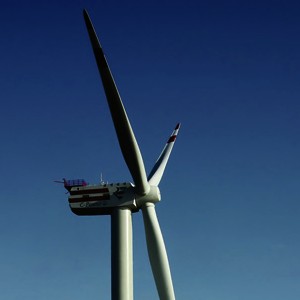Tuning the gear and the grid
 Air-core inductors, coiled in yellow insulation, simulate events on a large power grid. Photo by Ryan Schkoda.
Air-core inductors, coiled in yellow insulation, simulate events on a large power grid. Photo by Ryan Schkoda.Whatever the source of renewable energy, electrical power on a commercial scale moves on a grid. The Duke Energy eGrid tests new equipment “in the loop,” to learn how generators, controllers, converters, and various other elements perform together in a working grid.
Curtiss Fox, director of operations for the eGrid center, first envisioned the grid simulator when he was a Clemson graduate student and intern at the Clemson University Restoration Institute (CURI). Fox uses a large amplifier—an arbitrary waveform generator—to supply realistic electrical loads. Drawing only a few volts of energy supply, the amplifier can produce up to fifteen million watts. In a room carefully sealed against intruders, coils of air-core inductors replicate the inductance of power lines across a large electrical grid. Here, researchers can study events as they would transpire over many miles of grid, simulating, for example, the physical faults that occur when a falling tree knocks one power line against another line or drops it on the ground.
But don’t even ask about touring this room full of yellow-sheathed inductors.
“We’re trying to do exactly what the codes say not to do,” says Ryan Schkoda, as we peer through a heavy-duty wall of glass. “We’re doing it as safely as possible, and the faults are happening inside equipment designed to handle them. And the key to enter this room is inside the breakers. So if the power’s on, you can’t even get to the key.”
Schkoda and his collaborators use the eGrid to observe how wind turbines interact with the grid. “Instead of having tens or hundreds of miles of power lines, you can put these air-core inductors in series with the supply voltage and make the wind turbine think the power is coming from nearby or from far away, depending on where you set the switches,” he says. “So if you do have a fault, say in the nacelle—maybe the converter shorts out or maybe the gearbox breaks and the high-speed shaft has to stop—the resulting electrical forces depend on the grid you’re attached to.”
The grid’s reaction can be very different, he says, if you’re close to a city versus in the countryside at the end of a distribution line. So Fox and the eGrid team use a real-time digital simulator to study the dynamic conditions on a power grid. On their computers, they can track and evaluate the kinds of problems that are unknown to most consumers but bedevil utilities on a regular basis: fault ride-throughs, harmonics, and various other exotic phenomena.
In the effort to increase renewable energy, this has long been a missing link: the ability to tune both the grid and the generating equipment for safer, more efficient operation. For Ryan Schkoda, having the eGrid will help ensure that wind-turbine testing accurately reflects the realities of the grid. “As we move into dynamic testing,” he says, “we’re planning it one hundred percent with the eGrid.”
Clemson’s wind-turbine drivetrain testing facility is one step toward building a national powerhouse in renewable energy research and development. Next up? The sun.
How do you tune a huge turbine to the forces of nature and help deploy the next generation of green-energy machines?
The Duke Energy eGrid is a collaboration of Duke Energy and Clemson University. TECO-Westinghouse partnered with eGrid to supply the amplifier described in this article.




